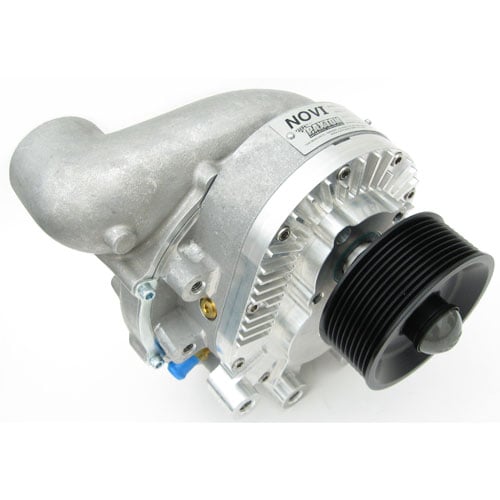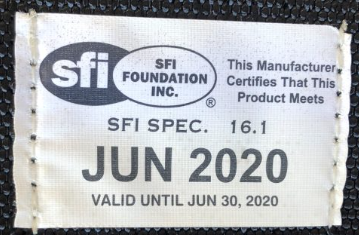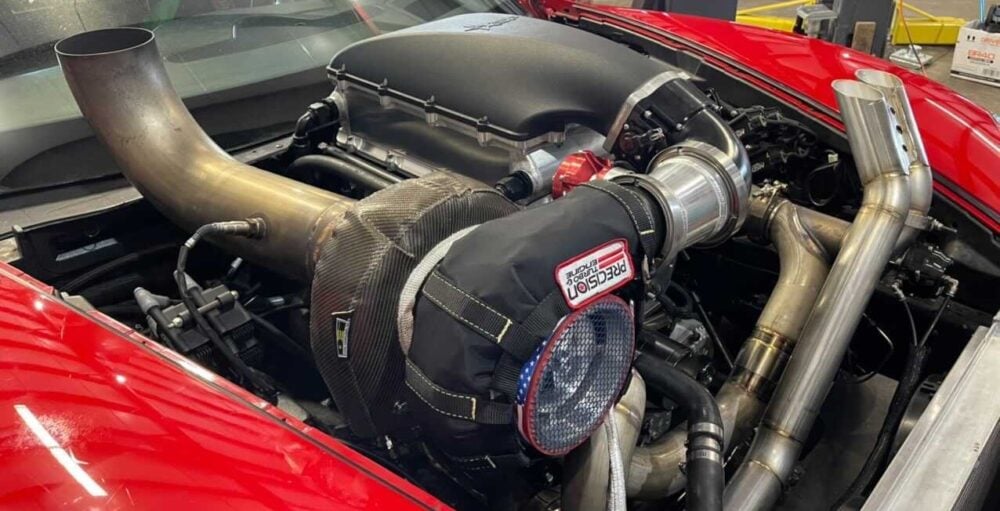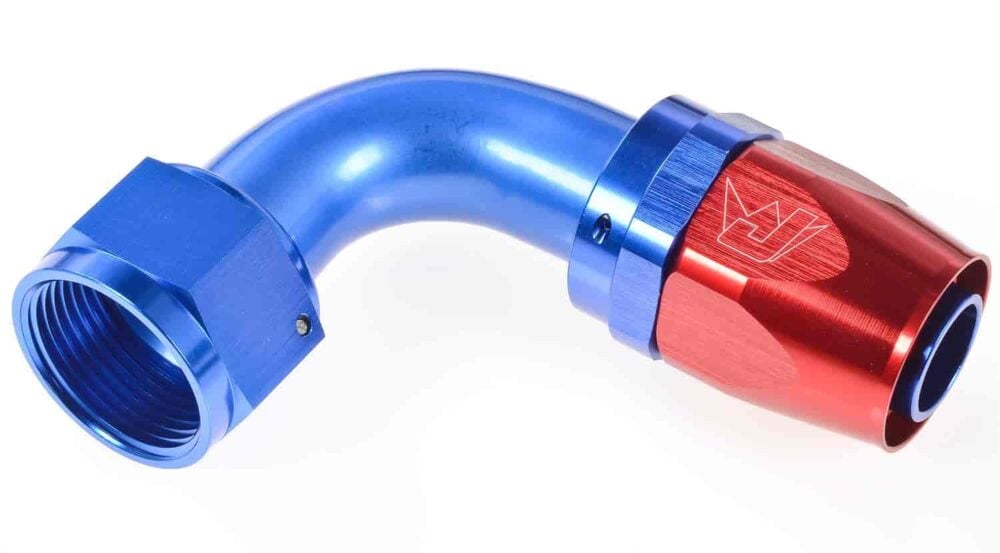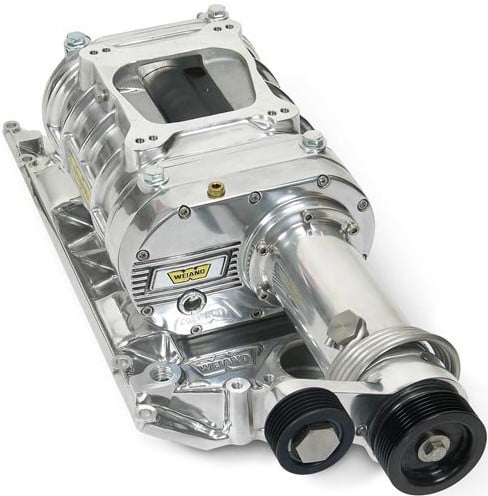
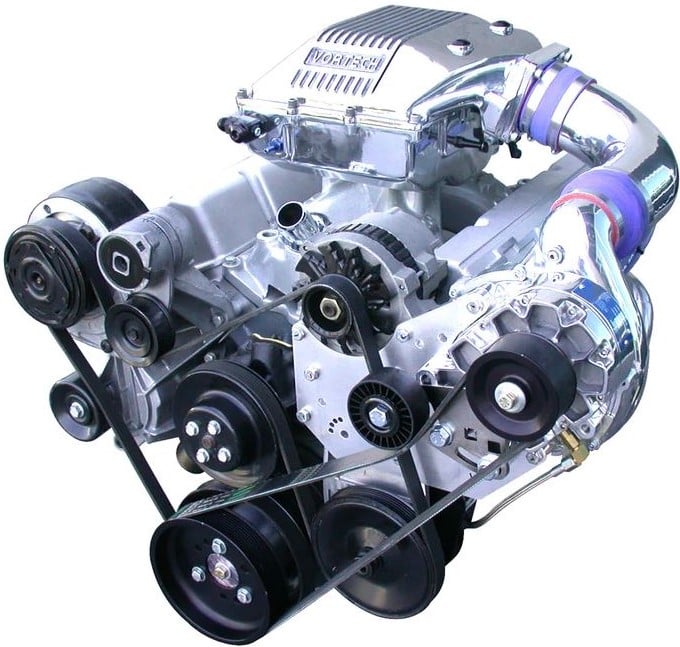
Superchargers are engine components that provide a large boost in horsepower and torque to engines by forcing additional air into the intake system. This type of power adder is very popular in race applications as well as on the street or under the hood of a muscle car or hot rod. But how exactly do superchargers and blowers work? The answers to this and other questions can be found below:
What Does A Supercharger Do?
“What do superchargers do?” is a common question asked by many looking for more power and performance. A supercharger is a belt-driven air pump, which compresses and packs air into an engine. Combined with additional fuel and then ignited, the result is a much bigger explosion in the engine cylinders, pushing harder on the pistons, spinning the crankshaft faster, and giving the engine more torque and horsepower. Often people wonder what the difference is between a supercharger vs blower. However, both names describe the same thing. The term, "blower", typically refers to the older roots-style supercharger found sticking up from the top of the engine on racecars and street machines. "Supercharger", on the other hand, can refer to the two main types of superchargers: Positive displacement, which includes "roots" and "twin-screw" designs, and "centrifugal" superchargers. Read on to learn more.
Roots-Style Superchargers
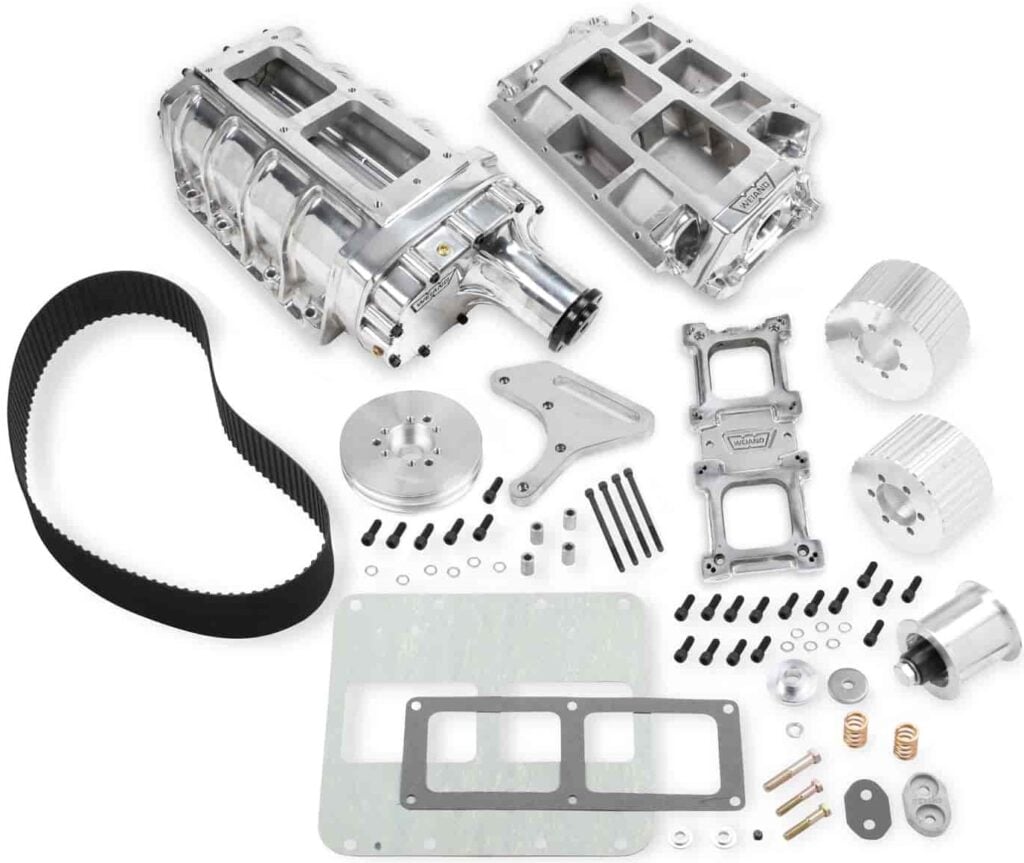
Roots-style superchargers (or “blowers”) are the most popular type of "positive displacement" design, compared to the "twin-screw" option as they are simpler and cheaper in design. The roots superchargers are bolted in place of the engine intake manifold. The carburetor or throttle body is bolted on top of the supercharger, causing outside air to be pulled through it instead of forced or pressurized air traveling through it. A Roots blower does not compress the air inside the supercharger. It is actually an air pump. The compression of the inlet charge / creation of boost actually takes place in the cylinders and the manifold. Centrifugal superchargers and screw type superchargers are called "internal compression" blowers because the air compression takes place inside the supercharger. Roots superchargers are "external compression" blowers because the air compression takes place outside of the supercharger. Roots type superchargers first appeared in automotive applications as far back as the 1930s. The basic design of a Roots supercharger has been developed over many years and has resulted in a highly-refined product offered by Holley under the Weiand brand. Roots blowers have been used on GMC diesel engines for many years. In the late 1950s, Phil Weiand was in the forefront of the development and adaptation of these superchargers for racing and performance applications. The company was active in producing manifolds and drive systems for adapting GMC diesel superchargers, such as the 4-71 and 6-71, followed by the development of its own superchargers that are completely manufactured by Weiand (including 8-71 through 14-71 models).Roots-style superchargers have the best throttle response when compared to centrifugal superchargers, as the air is pressurized immediately before the cylinder heads with short runners, eliminating restrictions to airflow. However, due to the height of the roots design, in most cases, the hood will need to be cut to allow the supercharger, carburetor, and scoop/air cleaner assembly to fit through it. In addition, the engine power required to operate a roots-style supercharger is more than a centrifugal design.
Screw-Type Superchargers
The screw type blower appears somewhat similar to a Roots-type blower from the outside, but the internal rotors are quite different. In a screw-type blower, the rotors interleave one another and as the outside air is drawn into the blower the rotors progressively compress the air inside the blower as it passes along the rotors. These rotors require an extremely high degree of tolerance and, as a result, the screw-type supercharger is more expensive than a Roots.
Centrifugal Superchargers
The second type of supercharger, the "centrifugal" design, has the supercharger bolted alongside the other belt-driven accessories, with its design similar to an A/C compressor or a turbocharger (except driven by a belt instead of exhaust gases). An intermediate / charge pipe connects between the supercharger and the throttle body or carburetor. If it is used in a carbureted application, the carburetor sits inside an airtight box to keep the boost from leaking out. For throttle body applications, the pipe is connected directly to the throttle body air inlet. In both cases, pressurized air is forced through the carburetor/throttle body. Centrifugal superchargers have the advantage of fitting under the hood of most vehicles in low clearance applications. They also use a lot less engine power to drive. They also can produce more power at higher rpms than roots designs as the intake manifold runners are longer. However, due to the distance and air path between the supercharger and the cylinder head, they have a slight disadvantage when compared to roots-style blowers. This is because of routing and restrictions to flow as the compressed air travels to the cylinder heads. These type of superchargers run at extremely high speeds. To achieve these high speeds in the centrifugal supercharger, there is an additional internal step-up drive inside the blower. Due to the design of these units, the faster the impeller spins the more boost the blower makes. As a result, these units typically do not produce much power at low engine speeds because the impeller is not spinning fast enough to make much boost. If it were even possible to gear the blower so that it would spin fast at low engine speeds, it would then make too much boost at higher engine speeds.
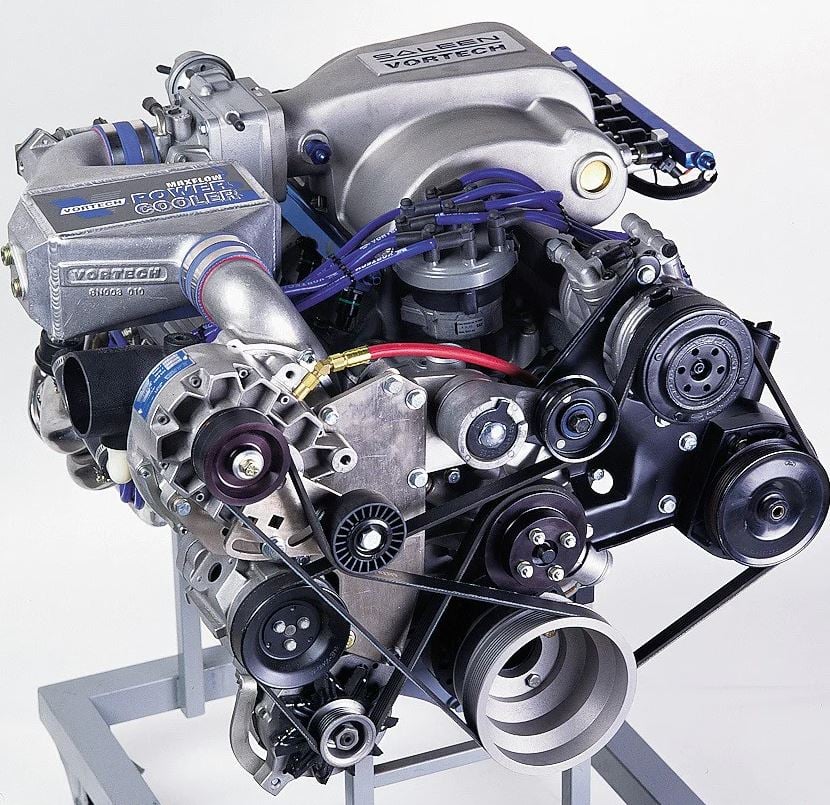
Supercharger Vehicle Applications
The best type of supercharger depends on the application being used. Positive displacement designs, such as Roots style superchargers/blowers are usually used on race cars with carbureted engines. Fuel injected engines typically use centrifugal superchargers on vehicles with low hood clearance or to keep the supercharger hidden from outside view.
What Does A Supercharger By-pass Valve Do?
A supercharger bypass valve is a component mounted between the supercharger and throttle body ( usually in the charge pipe). Its purpose is to recirculate excess air pressure back into the air intake stream before the supercharger inlet. The location where the air is routed is after the airflow sensor in order to maintain more consistent boost pressure and to help prevent tuning issues.
What Should Compression Ratio Be On Turbo vs Supercharger?
The best compression ratio for supercharging or turbocharging with a 5 to 8-pound boost range is 8:1 to 9:1 ratio when used with 92 octane gas. If the engine compression ratio is higher, less boost is recommended. If supercharger compression ratio from the engine is lower, more boost can be used. For any supercharger or turbocharger setup detonation must be controlled. Detonation in a supercharged/blown engine is more damaging than in a non-supercharged engine due to the increased heat and pressure. Damage to piston ring lands, or worse, will occur if a blown engine is detonating while driving. One component in controlling detonation is proper ignition timing, which is reduced as more boost is added.
What Type Of Vehicles Are Superchargers Used On?
Superchargers are typically found on racecars, boats, airplanes, as well as production vehicles, but can also be found on military vehicles and other applications. For automotive performance enthusiasts, superchargers are installed on street rods, hot rods, muscle cars, pickup trucks, and other vehicles to provide additional power and performance as well as turn heads at car shows and events.
What Is Supercharger Boost?
Per Weiand, "boost is the amount of air pressure created by the supercharger. Supercharger boost is largely misunderstood, even by some experienced performance enthusiasts.
One important thing to keep in mind with roots superchargers is that throughout the rpm range, the air ratio of the supercharger is consistent with the engine displacement. Supercharger boost, however, is not totally constant. This is because at lower blower speeds, the clearances between the supercharger case and the rotors allows for air "leakage" with some loss of boost efficiency. If your engine is not as free-breathing as it could be (because it has a stock or low performance camshaft, small valves, restricted ports, etc.) you will typically see the boost readings go up in the higher rpm ranges. This is because the boost the blower is making cannot fully get into the cylinders due to these restrictions, and the boost pressure starts building up in the manifold, which is typically where the boost readings are taken, therefore, artificially high readings will be observed. Interestingly, this means a supercharged engine can make more power with lower reading on the boost gauge.
Boost is a function of three things: the displacement of the engine, the displacement of the blower, and the speed that the blower is turned in relationship to the engine speed. There are a few basics to remember. Assuming a constant speed ratio between the engine and the blower, a larger blower will make more boost than a smaller one on the same size engine. As engine size goes up, boost goes down if the blower speed and blower size remain constant. Conversely, as engine size goes down, boost goes up. On a given size blower and a given size engine, boost can be increased by running the blower faster in relation to the engine's speed (overdriving) or it can be decreased by running it slower (under-driving).
As a very rough rule of thumb, you typically want to run larger blowers on larger engines. However, there is no reason you can't run a larger blower on a small engine, such as a 6-71 on a small block 327, as long as you adjust your drive pulleys to get the blower to run slow enough to keep the boost down to a level that is appropriate for the compression ratio you are running. Conversely, it is not practical to run a small blower on a big engine, because you would have to turn the blower so fast to make a reasonable amount of boost that the blower would become very inefficient, particularly at higher engine speeds. When Roots blowers are turned at very high speeds, they actually can heat up the inlet air to such an extent that the air expands substantially. This overheated expanded air loses so much density that even though your boost gauge says the blower is making boost, in reality you aren't putting any more air into the engine than an unblown engine would get.
Running the blower very slowly in relation to engine speed, such as would occur in our example above of a 6-71 on a 327, would result in inefficiencies at lower engine speeds. A slow turning blower, especially a larger one like a 6-71, would have a lot of low speed "leakage" of boost pressure past the clearances between the rotors and the blower case. This leakage reduces low speed boost pressure, with a resultant decrease in the amount of additional power produced. This is why it is important to have a blower that is sized in relationship to the engine displacement. In this instance, if the blower pulleys were selected to make decent boost at low engine speed, you would end up with excessive boost at higher engine speeds. Additionally, keep in mind that the larger the blower, the more potential for low speed boost "leakage" to occur because the total clearance path is much longer on a larger blower.
Many people assume a blower is making boost 100% of the time. In actuality, the blower normally only goes into boost when the throttle is opened substantially or when the vehicle is under load, such as going up a steep hill or pulling a trailer. In order to make boost, the blower must get air, and during most driving you will only have the throttle open a slight amount. Interestingly enough, even when not making boost, the spinning rotors improve the volumetric efficiency of the engine to the point where you can maintain high cruising speeds at lesser throttle openings, and in normal driving around town, you will notice that the vehicle is much livelier even when not making boost. This phenomenon can improve gas mileage under certain circumstances, although typically on an overall basis fuel economy will decrease about 3%. If your car was getting 20 mpg before the blower that means you will be getting 19.4 mpg after the blower installation but with a 40 to 50% increase in horsepower.
Weiand Pro-Street 6-71 and 8-71 supercharger kits come with drive ratios that will typically produce 5 to 7 pounds of boost. These boost levels are based on 350 or 454 CID engines. The 10-71 through 14-71 supercharger kits come with drive ratios that will produce 5 to 8 pounds of boost. These levels are based on a 502 CID engine. See our additional drive ratio charts at the end of this section. If your engine is smaller than this, your boost will be higher. If your engine is larger, your boost will be lower.
Boost will fall within a particular range, such as from 5 to 8 pounds, because a lot of factors can cause boost to vary. Depending upon how well your engine breathes, the amount of observed boost on a gauge can vary substantially. If you install a Weiand blower and your observed boost comes up on the low end of our estimated range, it means you have a really good breathing engine. Another factor that can contribute to low boost is a restricted air inlet or too small of a carburetor. Remember that at full throttle your engine is going to need about 50% more air than it did before the blower was installed. Are your air cleaner and carburetor capable of letting in 50% more air? If not, you won't make the boost that the blower is capable of.
The amount of boost that can safely be run is primarily determined by the compression ratio of your engine and the gas that you are using. As a basic rule of thumb, the 5 to 8 pound boost range that is provided by the standard pulleys supplied in Weiand's supercharger kits is suitable for compression ratios in the 8 to 9:1 range when used with 92 octane gasoline. If your compression ratio is higher than this, you will have to run less boost. If it is lower than this, you can run more boost. The key to any supercharger installation is that detonation must be controlled. Detonation in a blown engine is more destructive than in an unblown engine, and damage to piston ring lands (or worse) will occur if you continue to drive a blown engine that is detonating.
Many enthusiasts will experiment with increasing the boost until detonation occurs and then back down to the last boost level achieved without detonation. This requires purchasing additional optional pulleys. Remember that rarely are any two modified engines similar in how they react to boost and compression ratio combinations, so don't expect to copy what someone else may have done and achieve a successful installation. Unfortunately, as in many aspects of dealing with modified engines, trial and error is about the only way to achieve your ideal combination.
Please consult the manufacturer's charts and pulley section for help in determining the pulleys and blower sizes that will best suit your specific application. In most instances, this will provide you with enough information to provide a workable and safe combination that will provide substantial performance improvements."

The Relationship Between Compression Ratio And Boost Pressure
The compression ratio of your engine has a direct relationship to how much boost you can run. If you have a high compression ratio, such 9.5:1 or 10:1, you will only be able to run a small amount of boost.
The compression ratio that is built into your engine is called "static compression." When you combine the boost you are running in conjunction with your compression ratio, the result is known as the "Effective Compression Ratio." Formulas have been developed that convert your static compression and supercharger boost to the effective compression ratio.
Experience has shown that if you attempt to run more than about a 12:1 effective compression ratio on a street engine with 92 octane pump gas, you will have detonation problems. To some degree, this can be controlled with boost retard devices, but it is not recommended to set up an engine and supercharger to provide more than a 12:1 effective compression ratio. Please note that all engines differ in their tolerance to detonation. You can build what appear to be two identical engines and one will detonate and the other one won't. However, if you follow proper guidance, you will be close enough that if you do experience some detonation, it can be controlled with the use of an aftermarket boost retard ignition system. In addition, you can't try to run 10 pounds of boost on a 9.0:1 compression ratio engine as this gives you an effective compression ratio of 15.1:1, way beyond our 12:1 figure. If you are building your engine from scratch, it is a good idea to try to build it with a relatively low compression ratio, such as 7.5 or 8.0:1. It is fairly easy to change the boost to get the best combination of performance and power, but it is extremely difficult to change the compression ratio, especially if you want to lower it. Additionally, you will make more total power with a low compression, high boost engine than you will with a high compression, low boost engine.
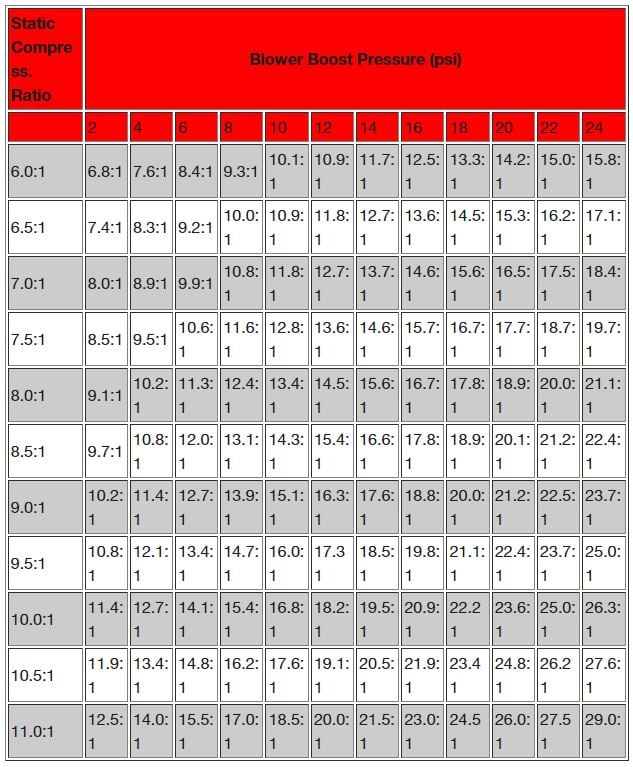
Supercharger Volume
In selecting the proper supercharger for your application, you also need to take into consideration how you plan to drive your vehicle and the approximate boost level desired. How you plan to drive your vehicle is important because you can set up your blower to be more efficient at high engine speeds or more efficient at low engine speeds, or you can arrange for the best compromise for the full engine rpm range.
For example, if your vehicle typically will be driven at speeds under 4,500 rpm and will never, or infrequently, see high engine speeds, you may want to select one of Weiand's smaller blowers. A smaller blower can be driven at a higher speed, which will produce a substantial amount of boost, particularly at lower engine speeds. However, this high blower speed will be less effective at higher engine speeds due to the overheating of the inlet air as discussed earlier. Conversely, if you choose a larger blower for this same application, in order to achieve the same boost level, the larger blower will have to be turned at a relatively slow speed. This combination will not produce the low end power that the faster turning small blower will, but will significantly outperform the small blower at high engine speeds. However, if you never drive your vehicle in the higher speed ranges, you may be giving up impressive improvements in the lower speed ranges. You may choose to do this anyway because you want the look of the larger blower and are willing to give up some bottom end performance.
To be more specific, the Pro-Street/ Marine 142 makes an excellent low to midrange blower for a 350 Chevy. The 6-71 is best for mid to high rpm ranges. The 8-71 is for all-out competition style engines that will see high rpm usage. The Pro-Street 177 is a good all-around compromise that will perform well across the board, but it still won't deliver as much power as the 6-71 or 8-71 at extreme engine speeds. These recommendations are based on setting up all three blowers at a similar boost output. On the big block, Weiand offers the Pro-Street 177 for good low to midrange power, the 6-71 for strong mid to high-range power, and the 8-71 through 14-71 for large displacement, high boost/rpm engines. The Pro-Street 256 is a good all around compromise.
Again, the 6-71 through 14-71 will outperform the smaller blowers in the high rpm ranges.
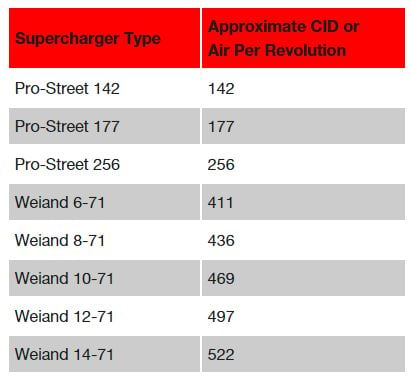
What Are The Benefits Of Using A Supercharger / Blower?
Per Weiand, "Installing a blower is one of the easiest ways to substantially improve a vehicle's overall performance, which can include the following:
- Improved starting. A properly set up blown engine will typically fire instantly, usually before the engine has even made one revolution. This is because the blower immediately is pushing the inlet charge right into the cylinder, rather than waiting for the engine vacuum to draw the charge into the cylinder.
- Substantial increases in low-rpm range performance. While this is true with all superchargers and blowers, it is particularly attributable to the smaller ones.
- Substantial horsepower increases. For example, bolting one of Weiand's Pro-Street Superchargers on an otherwise stock small block Chevy will result in an increase of approximately 100 to 120 hp. Usually with a mild blower cam and a larger carburetor you can expect a typical small block to produce anywhere from 360 to 400 streetable horsepower. The addition of a set of good heads can boost this into the 440 to 470 hp range. Torque on an engine of this type typically will be in the 400 to 440 Ib.-ft. range. All of these figures are based on a blower that is producing about 6 or 7 pounds of boost. A larger blower, such as Weiand's 6-71, on a similar engine to the one described above could push the top power output well over 500 hp. It is important to understand that for all practical purposes, an engine does not know what size supercharger is bolted to it. The amount of boost that is being produced by the blower is the critical factor. Power output estimates above are somewhat typical of any of Weiand's blowers, with the following exceptions: At very low engine speeds, the smaller blowers will typically produce more torque than the bigger blowers. At very high engine speeds, the larger blowers will produce substantially more power than the smaller blowers."
What Changes To the Engine Are Needed When Adding A Blower Or Supercharger?
One of the big advantages of a supercharger is that it can overcome many induction deficiencies in an engine, especially in the low to mid-range rpm area. Most blowers and superchargers can be installed on a stock engine, as long as the static compression ratio is 9:1 or less and engine speed is limited to 6,000 rpm. A majority of stock engines are equipped with cast pistons, cast crankshaft, two bolt main caps, and a small camshaft, requiring you to run very low boost pressure of 3 to 5 pounds maximum. Higher boost levels will cause detonation and engine failure.
To run boost levels from 6 to 10 pounds we recommend the following:
- Forged blower pistons with a static compression ratio of 7.5:1
- Steel crankshaft
- Four bolt main caps
- Steel harmonic dampener
- Stainless steel valves
- Three-angle valve job
- More aggressive camshaft
- Roller rocker arms
- Ported and polished heads
- Steel rods with quality rod bolts
- Chromoly pushrods
- High output ignition system
- High-flow water pump
- Minimum of a 2-1/2" diameter dual exhaust with headers. Recommended primary tube diameters and collector sizes are:
- Small Blocks: 1-5/8" to 1-3/4" with 3" collectors
- Big Blocks: 1-7/8" to 2' with 3-1/2" collectors
For maximum boost and horsepower applications (12 pounds or more), we recommend the following engine specifications:
- High-quality forged or billet crankshaft
- Four-bolt main caps with quality bolts or studs
- Steel harmonic balancer or crank hub
- High-quality steel rods (H or I-beam)
- Forged blower pistons
- O-ringing the block (MANDATORY)
- Severe-duty stainless steel valves or iconel
- Fully ported and polished heads
- Solid or roller cam designed for high boost
- Roller rocker arms
- Chromoly pushrods
- High-output ignition management system or magneto
- Blueprinted carburetors or fuel injection
- High octane race fuel (112+ rating)
- Minimum of a 3" diameter dual exhaust with free-flowing street/race mufflers and large tube headers.
- Recommended primary tube diameters and collector sizes are:
- Small Blocks: 1-7/8" to 2" with 3-1/2" collectors Big Blocks: 2-1/8" to 2-1/4", with 4" collectors
- Maximum effective compression ratio on gas not to exceed 24:1
It's important to realize that there are no hard and fast rules and the suggestions made here are general in nature.
Carburetion with a Blower
Choosing a carburetor is a very important step in building a blower motor. Under boost, the engine could need up to 40 to 50% more fuel and air, so it's key to pick a carburetor that is up to the task. If your carburetor can't provide enough fuel and air, you can't take full advantage of your supercharger and you won't be able to make maximum boost. In addition to providing fuel for the motor, the carburetor also is the restriction through which air must pass to get into the blower and the motor. Running too small a carburetor therefore means that you can't flow enough air to produce maximum boost. It's very simple: If a supercharger can't draw the air and fuel into it, you can't get horsepower out.
The amount your carburetor needs to flow depends on engine characteristics and on the amount of boost your blower will be making. There's a formula for determining the required carburetor cfm:

If your carburetor is too lean, it will cause detonation, which can destroy your motor. How do you know if it's too lean? You'll have several obvious indications, like glowing red headers, audible "lean pop," or engine surging. Even if you don't experience these conditions, you should still read your spark plugs for proper color. You want to see a medium to dark tan color.
If you run one or more Holley carburetors, be aware that they contain power valves. Power valves provide additional fuel when there is no vacuum at the base of the carburetor. However, in a blower application, there will always be some vacuum, so the power valves will not function properly. You will need carburetors that have a "boost referenced" power valve circuit. Holley "Supercharger Carburetors" are specifically designed with this feature. In addition, they also are 100% wet-flowed, equipped, and calibrated for the special needs of a supercharged engine.
Ignition Systems with a Supercharger
Many street supercharger applications will work fine with the stock ignition system, because blown engines make so much low and mid-range power, it is not necessary to rev to high rpm's. High performance ignitions are primarily required to provide adequate spark at higher than normal rpm's. If most of your driving is going to be under 5,500 rpm, you probably won't need an aftermarket ignition. For optimum performance at higher engine rpm's, select an aftermarket performance ignition system. It is usually a good idea to run spark plugs that are one to two ranges colder than normal with a blower. The more boost, the colder the plug required. Colder plugs will foul easier than hotter plugs, so in this instance a "hot" ignition may be advisable.
The main thing that needs to be addressed with a blower is to make sure that detonation is controlled. A handy device to have is an ignition system with a "boost retard control," such as the Holley Ignition P/N 800-450.
With the use of this unit, you can run normal timing settings which will allow for easy starting and reasonable fuel economy under normal driving situations. However, when you step on the gas and the engine goes into boost, this timing setting may cause detonation. With the "boost retard control," the driver can dial in ignition retard with a dash-mounted knob. These devices usually operate on a "degrees of retard per pound of boost" and are typically adjustable from 1 to 3 of retard per pound of boost. As an example, if the unit is set to deliver 1 per pound of boost, that means that when your blower is putting out 4 pounds of boost the distributor will be automatically be retarded by 4. When you reach 7 pounds of boost, it will be retarded by 7. Best results are achieved by driving the vehicle under boost and adjusting the unit until any detonation is eliminated.
NOTE: We do not recommend using these devices in marine applications. Retarding the timing under boost increases the combustion temperatures. On a street vehicle, this typically occurs for short periods of time. In marine applications the engine is usually in full boost all of the time. As a result, these prolonged high combustion temperatures can burn pistons or valves.
Most blown engines operate best on 28 to 34 of total timing. Running more total advance will not provide any performance increase. Your distributor should have a centrifugal advance mechanism that has been set up so that the entire advance is in by 2,500 rpm. The best way to set your timing is to put a permanent mark on your harmonic damper that represents 34 total advance. If your damper doesn't go this far, you can measure the timing marks on your damper and then, using your measuring tape, calculate where 34 would be. 34 is a very safe figure and should provide close to optimum performance.
After you mark off 34, start your engine and rev it up to a speed where the entire distributor's mechanical advance will be in. This should be somewhere over 2,500 rpm. Then read the new 34 mark like you would read TDC at idle speed. Adjust the distributor so that the new mark on the damper lines up with the "0" on your timing tab. This would provide 34 of total timing or if you wanted 32 of total timing, you could line up the mark on the damper with the 2 ATDC mark on the timing tab instead of "0."
Supercharger Engine Camshafts
The choice of camshaft can make or break a blower motor. A legend in the industry, Lunati offers several camshafts specifically designed to work with Weiand blower kits. In addition, the following are a few basic guidelines for selecting the proper cam for your motor. Obviously, the amount of boost your supercharger produces is going to be a factor in choosing a camshaft. Weiand offers three different levels of superchargers, and each requires a different type of cam.
The "mildest" of Weiand's blowers are the Pro-Street superchargers, which are set to produce from 5 to 7 pounds of boost. The company recommends a hydraulic cam for these applications - where the engine will not be spun past 6,500 rpm and has several grinds available. All of these cams are ground on a 112 to 114� lobe center line, which helps maintain cylinder pressure to maximize horsepower at these lower boost levels. Keeping the cylinder pressure up also gives you excellent throttle response. The milder cams that Weiand offers are great for street performance enthusiasts who want to gain about 100 to 120 streetable horsepower. The company also offers slightly "bigger" cams for the next performance level up.
For 6-71 and 8-71 blowers, Weiand again recommends running a hydraulic cam, as long as you keep the boost level below 10 PSI. Weiand also offers cams for these type of applications. For your higher boost levels (which includes all 10-71, 12-71, and 14-71 applications) in gasoline burning engines, the company recommends running a flat tappet or roller cam with a 110 lobe center line. This cam design provides good overall power on pump gas and also aids in engine cooling. Plus, the 110 center line provides even sharper throttle response and helps lower initial cylinder pressure (you won't miss the cylinder pressure with these blowers, since they make plenty of boost).In all supercharger applications, Weiand recommends running roller rockers and chromoly push rods.
Supercharging is an extremely effective way to reliably increase horsepower and torque, particularly in the low to mid rpm ranges where most street machines are operated. Unfortunately, due to the wide use of superchargers in drag racing, many people think a supercharger is an exotic race component and is not truly suitable for the street. Now that supercharging is becoming quite common on stock factory vehicles, more people are realizing that a supercharger is a safe, practical source of performance increases. Superchargers are currently available on several Ford models, as well as Buick and Pontiac cars. These are all Roots type superchargers and operate on the same basic principle as all of Weiand's superchargers.
Can't Find The Supercharger You Are Looking For?
A JEGS expert is ready to answer your questions and help you find the supercharger you require for your specific application as well as the question, “what are superchargers?”
